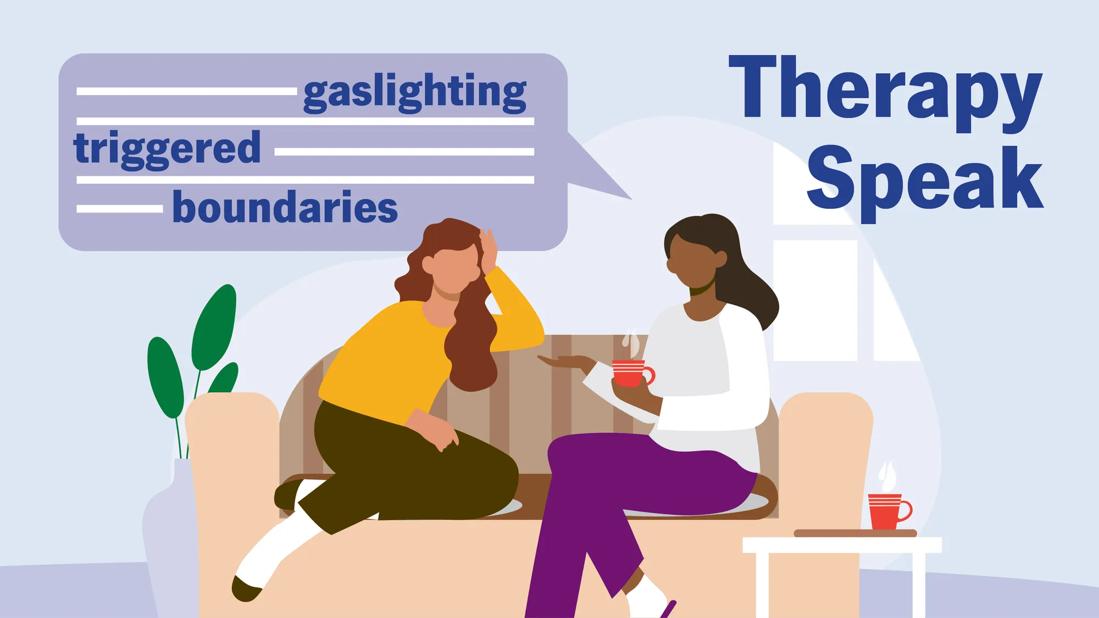Using terms like ‘gaslighting,’ ‘trauma dumping’ and ‘boundaries’ in your everyday life may not be healthy or productive

After getting into a consistent therapy schedule, you suddenly have the words for what you’ve been feeling for years. And it feels deeply validating. Finally, you have a dictionary of terms that perfectly describe tough emotions around trauma, depression, anxiety and more.
Advertisement
Cleveland Clinic is a non-profit academic medical center. Advertising on our site helps support our mission. We do not endorse non-Cleveland Clinic products or services. Policy
Now, you feel more comfortable using these “therapy speak” terms all the time, even outside of your therapist’s office. And while this vocabulary can serve as an important tool for people to understand their emotions, some mental health providers caution against overusing them in personal relationships.
Psychologist Natacha Duke, MA, RP, breaks down what therapy speak is, some examples of it and how to use these phrases in a way that’s helpful, not harmful.
“Therapy speak” is when people use psychological phrases and mental health language in their daily lives. Since therapy has become more popular and accessible, terms like “gaslighting,” “trauma dumping” and even “boundaries” have started to overflow outside the therapist’s office. You may have heard therapy speak come up in casual conversation, online or even during moments of conflict.
Some examples of how therapy speak might be used in everyday life:
Advertisement
The terms used in therapy may vary from person to person. But in general, there have been a few therapy terms that have risen in popularity and, in turn, have a higher risk of being misused. Here are the top five to know about.
“Trauma” is a complicated term that is very subjective. And lately, there have been a lot of offshoot terms popping up that relate to trauma.
First is “trauma bonding,” a term that’s often misunderstood. While it’s not an official diagnosis, it does get used a lot. “It’s when we bond with someone emotionally after a maladaptive pattern of interaction, usually abuse,” Duke explains.
An example of trauma bonding is when someone becomes emotionally dependent on their partner who is continually abusing them in some way. In this way, it becomes a part of the cycle of abuse where the person can’t get out of the trauma bond.
But it’s possible to mischaracterize trauma bonding. “Oftentimes, you hear it being used for relationships that are just not working,” continues Duke. And while you may be right about a relationship not working, it doesn’t always mean that trauma bonding is playing a role.
For example, if there’s a stressor in your relationship that keeps bubbling up and then going away, it may not necessarily mean you have a trauma bond. The repeated occurrence of the issue could just mean that you and your partner aren’t resolving the problem and it keeps getting pushed to the side.
Then, there’s “trauma dumping,” which is the act of sharing intense, personal or distressing experiences to someone without warning.
Maybe there’s someone just trying to share something with you, and maybe you are struggling with not knowing how to handle it. Or it’s on the flip side, where you’ve been accused of being a trauma dumper after sharing your emotions. While trauma dumping definitely happens, it’s not one-size-fits-all.
For example, if someone asks you if they can share something difficult, they’re practicing a healthy way of venting. At times, we may say “yes” in situations like this, even if we’re not in a good place to receive the information. But it’s unfair to right away call it “trauma dumping” if the person is trying to be mindful about it.
“In some cases, a person who’s receiving the information may not have the capacity to hold it. And that’s why they’re using the term ‘trauma dumping.’ And that’s OK,” Duke notes. “Not everyone has the capacity or space to hold someone else’s emotions because they might be working on their own stuff. But there’s more constructive ways to talk about that.”
“Gaslighting” is one you may have heard of a lot. It’s often used widely on social media, TV shows and other pop culture scenarios. It’s often used to describe a person invalidating someone else’s experience by denying that it’s real. In many cases, this can cause a lot of harm for someone, especially if it’s done over long periods of time.
Advertisement
If you think that you’re being gaslit by someone, it can be tempting to call them out on it and use the label ‘gaslighting.’ But as Duke explains, it may be more helpful to say: “I don't feel you’re making space for my thoughts and feelings.” That may bring out a less defensive response from the person you’re trying to reason with.
Try to focus the conversation more on how the other person is making you feel. That may help you both be in tune.
The term “boundaries” is often used to create healthy distance or space between a person or situation. If you’re someone who struggles with anxiety, paranoia or people-pleasing, you may have been advised to “set healthy boundaries.”
This often means, making sure you don’t over-schedule, limiting time with people who are emotionally harmful and simply saying “no” when you don’t want to do something.
The key to practicing healthy boundaries is to focus on what you can control: your time, emotions, money, etc. Setting boundaries isn’t about trying to control what others do or completely shutting yourself off from other people.
Some examples of using boundaries in a healthy way include:
Advertisement
On the flip side, you could also use boundaries in an unhealthy way that’s damaging to your relationships, including:
Have you ever felt the urge to say a friend is being “OCD” just because they keep an extremely tidy home? Whether you’re doing it in a lighthearted way or not, it’s best to avoid this term. As obsessive-compulsive disorder is a real, diagnosable condition that affects many people, you don’t want to put your foot in your mouth with this one.
And as Duke points out, it doesn’t help that OCD is very often misunderstood and confused with things like perfectionism and tidiness. “It takes more than being tidy to have OCD,” she states.
The main thing to know about narcissism is that it’s a personality disorder with very specific criteria. Duke shares that sometimes, certain symptoms or signs of narcissism can show up in a person’s personality without them having the disorder.
Advertisement
“Someone showing selfishness doesn’t automatically mean they’re a narcissist,” she explains, adding that the condition goes way deeper than that. “It really stems from questioning one’s self-worth.”
This may be one of those terms that may serve you best within a support group or with a trusted friend.
The best way to use therapy speak will depend on the specific situation. But in general, here are some guidelines around using these terms outside your therapist’s office.
If you’re doing it just to seem intelligent and to “one-up” someone, you may not be using your newfound terms for the right reason. Especially if you’re in the middle of a conflict with someone, it can feel liberating to have these words to voice your own experience.
But it’s always better to come from a place of “Let me share this new term I learned” rather than “Here’s how much I know and you don’t.” Duke points out that if you find yourself using these terms out of spite instead of good faith, then it may not be a good idea to use them at all.
Just because you’re aware of certain terms from therapy, doesn’t mean everyone else around you is. So, it’s important to meet people where they are. Remember: There was a time when you didn’t know these terms either.
It can be easy to assume everyone around you is hip to therapy speak, but that’s not always going to be the case. Give people grace and patience where it’s needed. It’s also a good idea to ask your therapist about how you should translate certain terms for people who aren’t as familiar with them.
Try and break down the meaning of each term and explore language around how the other person is making you feel. That may help you and them get on the same page.
It’s always better to err on the side of caution by introducing the term gently, like, “Have you heard of this phrase? Here’s what it means. What do you think?”
While not all of these terms refer to a specific diagnosis, many of them are related to actual conditions. Calling someone “OCD” or a “narcissist” isn’t a good idea (especially if the person doesn’t want to talk about a possible diagnosis they may have).
If you really want to help someone pursue a diagnosis for their own well-being, try recommending a therapist or support group. Even sending a helpful article defining the term can be a gentler and more appropriate way to help them learn about their situation.
Depending on who you’re speaking with or what the situation is, therapy talk may not be the best tool for resolving conflict or tackling other interpersonal problems. If you feel like you’re not getting anywhere by using these phrases, it may be best to keep them in therapy. This is often where the context of these terms exist.
If you’ve ever used therapy speak, there’s a good chance you had good intentions behind it. But even if your goal is to use psychological terms to make your emotions clear and fix your relationships, they may not always land how you want them to.
Use therapy speak sparingly and mindfully when you’re in your everyday life. And when in doubt, skip them altogether and use simple language focused on how you feel.
Learn more about our editorial process.
Advertisement

A single song can go a long way in helping you focus, recall memories and develop new neural connections in your brain

This alternative brain-body therapy focuses on unlocking pent-up feelings, memories and tension that may be stuck in your brain and body

Research types, find a therapist who fits you and remember — therapy isn’t a sign of weakness

Past negative experiences can affect you throughout your life

There are a variety of therapies, all of which can help you function better in your everyday life

It’s nothing like your average arts and crafts session

Getting therapy isn't a sign of weakness

The best parenting style balances enforcing rules and showing plenty of love

Tips include cutting back on sugar, focusing on exercise and managing stress

It can be harder to let go when you’ve invested time, energy and emotions — but it might be the healthier choice long term